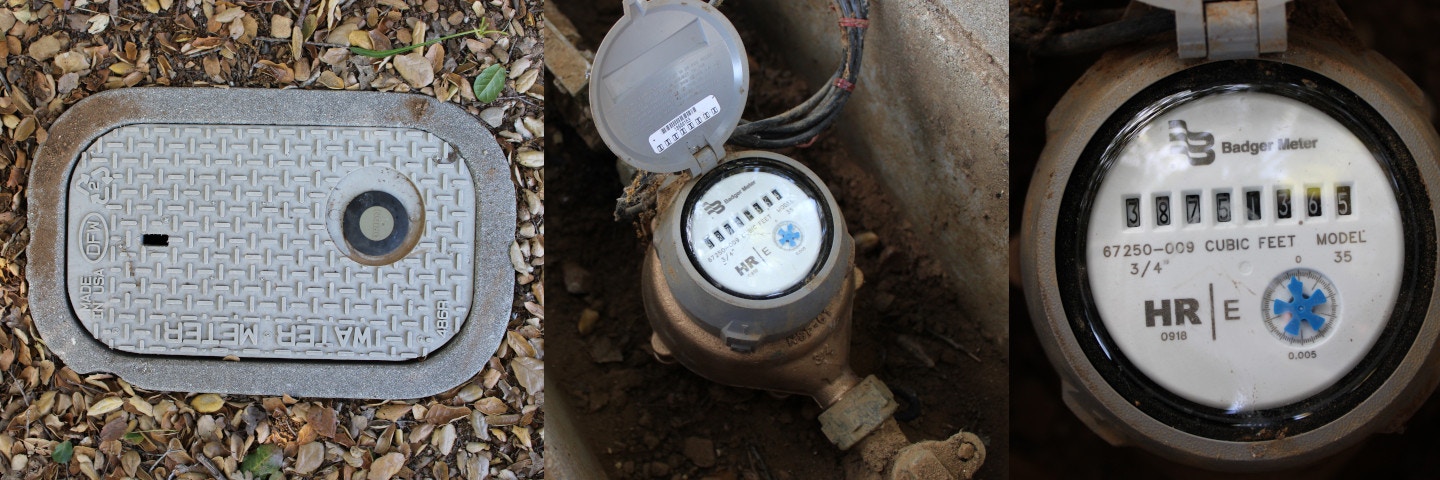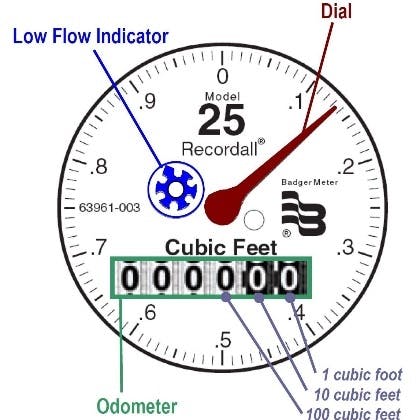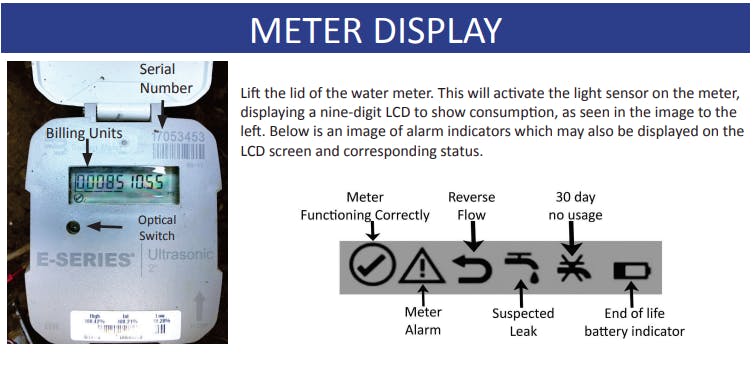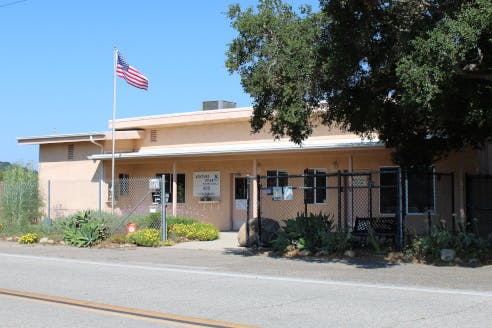
Monitor Your Use
Meter
Reading Your Meter
Your water meter plays a crucial role in measuring your household's water consumption. The readings from your meter determine the charges on your monthly water bill. Additionally, you have the option to personally read the meter for various purposes, such as verifying your bill, keeping an eye on your water usage, identifying potential leaks, or experimenting with more water-efficient landscaping practices.
Locate Your Meter
Your water meter is generally located near the curb in front of your home or on the property line. Meters are typically housed in a concrete box. Carefully remove the lid by using a tool such as a large screwdriver or pliers. Replace the lid by sliding it back into place. Be careful not to drop the lid on the meter.
Analog Water Meter
VRWD currently has two different types of water meters currently placed in the district. Most of the meters look like the one pictured below.

Dial
The dial will rotate when water passes through the meter. One full rotation of the dial equals 1 cubic foot of water or 7.48 gallons.
- Water meters measure cubic feet of water used. To convert cubic feet to gallons, multiply the number of cubic feet by 7.48.
- VRWD measures water use by units for billing purposes: 1 unit of water billed = 100 cubic feet = 748 gallons.
Low Flow Indicator
The Low Flow Indicator will rotate with very little water movement. Any water moving through the meter is detected so even small leaks will register.
Odometer
The odometer records total water use in a similar way as the odometer in your car records miles driven. The water meter odometer records water use in cubic feet and displays as follows: The digits from right to left represent 1 cubic foot, 10 cubic feet, 100 cubic feet and so on. Like a car odometer, the water meter odometer can not be altered.
Digital Water Meter
- Carefully remove meter box lid (one component of your meter transmits through the top of the meter box lid)
- Once the lid is removed, set it carefully next to the meter box and do not remove any of the wiring.
- Flip open the lid to the meter itself and wait a few seconds.
- The meter toggles between the read and the flow (see below).
- Watch this video for more detailed information. Water Meter Detailed Information Video
- **Remember! If you have this type of meter, get logged on to the Eye on Water website to monitor your use and set up text/email leak alerts! Call 805-646-3403 for more information.
Read your Smart Meter online at www.EyeOnWater.Com

How to Monitor Your Water Use
The following steps will show you how to determine how much water you use over a period of time.*
- Read the odometer and write it down completely. Then write down the date you read it. After a period of days (we suggest 7 days) read the odometer again and write it down and write down the date.
- Subtract the first reading from the second reading. This is your water use in cubic feet during the period.
- Multiply the water use by 7.48. This is your water use in gallons during the period.
- Divide the water use in gallons by the number of days between readings. This is your average gallons per day during the period.
Check For Leaks
Checking for leaks is a simple yet crucial step in maintaining a sustainable and efficient water usage. Small drips and unnoticed leaks can add up to significant water wastage over time, resulting in higher water bills and unnecessary strain on our precious water resources. Regular leak inspections not only help save money but also prevent damage to your home and property.
Check for a leak by turning off all water indoors and outdoors including sprinklers, ice maker, etc. check your water meter, if the low flow indicator moves, this may indicate a leak in an appliance or pipe. If the meter shows no obvious movement, note the reading on the meter and return in 3 hours to see if there is any change. Note: if you use water during that time, the meter reading will change. If you do notice movement, check all appliances, faucets, toilets and other water sources for drips or leaks.
Other Leak Detection Tips
- To determine if the water leak is in the house or outdoors, turn off the shut-off valve on your home’s main water supply pipe.
- Check the water meter, write down the numbers, and wait another hour. When you check again, if the numbers have not changed, the water leak is inside your home. If the numbers have changed, the leak is in the buried water line that runs to the house, or in the irrigation line outside the home.
- Check for patches of Greener Grass
- It could indicate the spot where a buried water line is leaking. If the leak is profuse, your might even see some puddles on the surface of the ground
- Check your water softener
- Sometimes water softeners can malfunction and will continue to recharge which looks like a “leak” without any water appearing
- Dye Test the Toilet
- Not all toilets running are noisy. Toilet flappers can become brittle over time. Grab a bottle of food coloring and put a few drops in the tank of every toilet in the house. If a toilet tank is leaking, color will appear in the bowl within five minutes. If you find color in the bowl, call a plumber or, if you’re handy with DIY projects, you can probably replace the flapper yourself.
- Check Irrigation Systems
- Inspect your outdoor irrigation system for damaged or misaligned sprinkler heads and leaking hoses or pipes
- Inspect Water-Using Appliances
- Check for leaks in and around toilets, faucets, and showerheads. Replace worn-out washers or seals.
Please Note: VRWD does not repair leaks on the customer side of the meter. That is the customer’s responsibility. You may wish to call a plumber because hidden leaks can be very expensive.
Eye On Water
EyeOnWater helps customers understand their water usage, detect leaks, and discover their watering trends. Over 50% of our customers and counting have access to this technology! Watch this informative EyeOnWater video below to learn how to get started with your Smart Meter!
Creating Your EyeOnWater Account
Once you’re online, follow these simple steps to create your account and start using EyeOnWater:
- Visit eyeonwater.com/signup
- Enter your account number as it appears on your water bill, including the dashes.
(If you don’t have a copy of your water bill, contact VRWD at (805) 646-3403 to get your account number)
- Enter your email address
- Verify your email address in the confirmation email
- Create and confirm your password
- Read and accept the Terms of Use
- Enjoy EyeOnWater!
Frequently Asked Questions
When is my bill due?
All bills are due when presented for payment. Bills are overdue if payment is not received by the last day of the month.
Why wasn’t my last payment reflected on my bill?
In order to process the billings each month, the District must establish a transactions cut-off date after which no further transactions will be reflected on the monthly billing statement. If your payment was received after the cut-off date, it would not be reflected on your bill.
Do you have a leak relief program?
Yes. Leaks that are greater than 40 units of water and are unavoidable! Other criteria applies. Go to our forms center to apply.
Are water waste prohibitions in effect?
Yes, see more under conservation.
Why is my bill so high?
Our volumetric rates are tied directly to water usage. Your usage likely increased. Look at your bill period dates and try to remember if any water events happened, changes in irrigation, family visiting etc. that could’ve changed your typical water use. Water bills are typically higher during the summer months.
Can you tell me where my leak is?
No. VRWD can not help you find your leak.
How can I conserve?
For conservation tips visit our water conservation page!

